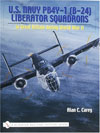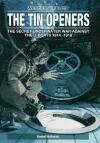Business in Great Waters
The U-boat Wars, 1916-1945
Terraine, John
1997, Trans-Atlantic Publications, Inc.
ISBN 1840222018
| Type. | General History |
| Pros. | A very thorough, well-balanced and engrossing text covering the entire history of North Atlantic U-Boat operations in both World Wars. |
| Cons. | Nothing major. - Don't be put off by the photo of the rather antiquated-looking British submarine on the cover of the paperback edition! The fates of a few individual U-boats need to be corrected, but this does not detract from the narrative flow |
| Rating. |  |
 This excellent volume, first published in 1989, has recently been re-released as an inexpensive paperback. Author John Terraine’s unique 'big picture' explanation of the strategy and execution of the U-Boat wars is extremely enlightening - even for the enthusiast who is already quite familiar with this subject. The title of this book is derived from Psalm 107 "They that go down to the sea in ships; that do business in great waters" - very appropriate for this epic topic.
This excellent volume, first published in 1989, has recently been re-released as an inexpensive paperback. Author John Terraine’s unique 'big picture' explanation of the strategy and execution of the U-Boat wars is extremely enlightening - even for the enthusiast who is already quite familiar with this subject. The title of this book is derived from Psalm 107 "They that go down to the sea in ships; that do business in great waters" - very appropriate for this epic topic.
Terraine begins his story by explaining and analysing the German U-Boat offensive of World War One. It is very interesting to see the way in which the lessons of the first war (both remembered and forgotten!) so strongly influenced the conduct of the second.
At the start of WWI the submarine was very much an untried technological innovation. All of the doctrines of attack and defence had to be developed from scratch. This development occurred with impressive speed. By 1917, the US Ambassador to Britain called the U-Boat, "the most formidable thing the war has produced - by far - and it gives the German the only earthly chance that he has to win."
In 1915, 80% of all U-Boat attacks were executed under quaint, gentlemanly rules of engagement; the merchantmen were stopped and searched, the crews seen to their lifeboats, and the ships scuttled. As time went on, the British Admiralty started arming the merchantmen with defensive guns and the U-Boat commanders slipped more and more towards the brutal business of conducting submerged attacks on unsuspecting targets. In 1917 a massive 'unrestricted' U-boat campaign was embraced by the German Government as their only hope for knocking out the British war economy before Germany itself collapsed. The ruthless conduct of this form of warfare created dire problems for Britain, but it also prompted America to take the historically significant step of abandoning its isolationist foreign policy and entering WWI.
Terraine relates many surprising facts about the WWI campaign. The total number of ships sunk by U-Boats in WWI actually exceeded that of WW2! (Although the total tonnage was lower.) The all-time records for individual U-Boat operational successes also date from the first war. The most successful commander was Lothar von Arnauld de la Perière, (sinking double the tonnage of WW2’s Otto Kretchmer). Arnauld de la Perière’s boat (U 35) remains the most successful in history. He also conducted the most destructive single patrol ever in July/August 1916, sinking 54 victims within four weeks - while still adhering to the gentlemanly 'prize rules'!
Up until 1917, the gigantic British Navy was embarrassingly unable to deal with the U-Boat threat. Entirely new categories of anti-submarine weapons had to be invented and frantic scientific efforts were focussed on U-boat detection techniques. The horrifically wasteful 1917 ground offensive at Passchendale was even launched in a vain attempt to capture the U-Boat bases in Belgium! Fortunately, British technological progress was rapid, with depth charges and hydrophone underwater listening devices being successfully introduced. (The first prototype echo-location equipment was also developed by the British ASDIC committee.) Additionally, 'Room 40' of the Admiralty successfully broke the German naval codes.
However, the main solution to the U-boat panic turned out to be the establishment of escorted merchant convoys. Sadly, a woeful catalogue of delay and dithering attended the introduction of this tactic in WWI. Many in the British Admiralty believed at the time that it would only create bigger target concentrations for the U-Boats! In fact, the U-boats proved largely unable to find the convoys in the broad expanses of the ocean.
By the summer of 1918, the introduction of convoys, guarded by specialist escort vessels, airships and aircraft, had stemmed the British losses. However, as Terraine relates, the U-Boats had only been foiled this time, not defeated. It was actually the disintegration of the German war economy in 1918 that brought about the surrender of the U-Boat fleet. The 1919 Treaty of Versailles then banned the Germans from building any more U-boats. This seemed to resolve the issue permanently. However, clandestine German Navy enthusiasm continued for this prospective war-winning weapon.
The British rapidly forgot many of their hard-won lessons of 1914-18. When German militarism re-emerged in the mid-1930s the Royal Navy complacently believed that convoys plus ASDIC would be the complete solution to the U-Boat problem. (Although experienced veterans from the first war were also, fortunately, striving to re-establish the codebreaking and intelligence infrastructure which had been so useful twenty years before.)
Ironically, the German Supreme Naval Command also neglected the lessons of the previous war. They too were convinced by the impressive-looking British ASDIC technology. They gave production priority in the late 1930s to battleships! Fortunately for the German Navy (and, as it was to transpire, very unfortunately for the Allies) they had an important dissenting thinker in the person of Karl Dönitz, the dedicated leader of the reconstructed U-boat fleet. In only four brief years from 1936, Dönitz built up a small but highly effective force. He applied his WWI command experience, plus his ideas on how to use radio-coordinated attacks to solve the 'convoy problem', to train and motivate his men to a very high standard of preparedness. When war with Britain arrived rather unexpectedly in 1939, Dönitz’s meagre fleet sprang into action with astonishing success.
Terraine devotes the last three quarters of his book to the various phases of the U-Boat war which raged from the first to the last day of WW2. He relates this complex story in a remarkably clear manner. His approach is to concentrate on the really pivotal events -- the ebb and flow of the worldwide land and air campaigns, the political decisions and the technological breakthroughs. Key convoy actions at sea are examined in detail, again focussing on those convoys where major trends in technology or tactics emerged. The important roles played by both Allied and German codebreaking are well covered, as are the hundreds of other factors which influenced the campaign. Terraine often quotes the contemporary accounts of the participants on both sides, adding a measure of dramatic action to the broader story of command and control. In many places the book reads like a digest of the best 'quotable quotes' from the political leaders (Churchill, Roosevelt, Hitler), the military commanders (Dönitz, Horton, King and many others), the fighting men (such as MacIntyre, Gretton, Monsarrat, Walker and Werner) and the most respected historians (Rowher, Roskill, Middlebrook etc.). Each adds perspective to Terraine’s own lucid commentary.
The end result is an extremely thick book which still begs to be read from cover to cover! Terraine’s writing style is most enjoyable. His extensive indexes also ensure that information on almost any topic related to the U-Boat wars can easily be located.
Review written by James Oglethorpe, Sydney, Australia.
Published on 18 Oct 2002.
This title is highly recommended.
Purchase information: (info) Get Business in Great Waters now at amazon.com ($ 31.01)
Get Business in Great Waters now at amazon.com ($ 31.01)
Return to our main review page.



